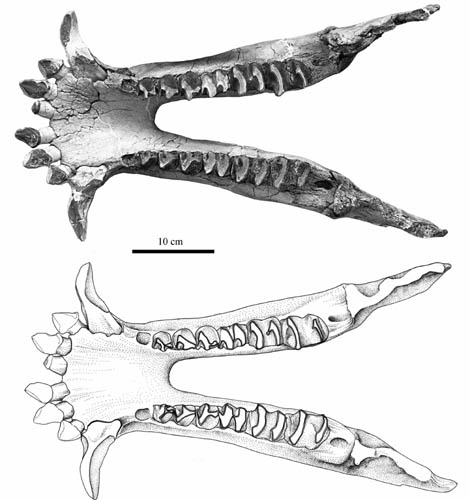Coryphodontids, are a group of extinct large herbivorous mammals widespread in Eurasia and North America from late Paleocene to middle Eocene, placed in the archaic, extinct order Pantodonta, and are among the most useful mammalian index fossils for stratigraphic correlations in North America. In Asia, however, they are rarely applied to strata correlation because of taxonomic confusion and misinterpretation of the lithostratigraphy of the fossil-bearing units.
The Erlian Basin of Nei Mongol, China is one of the most important regions in the world for research in Paleogene vertebrate paleontology and stratigraphy, and has yielded some well-preserved coryphodontid material. According to a paper published in the latest issue of Vertebrata PalAsiatica 2012(3), Dr. WANG Yuanqing, Institute of Vertebrate Paleontology and Paleoanthropology, Chinese Academy of Sciences, and his graduate student MAO Fangyuan, reported the new find of coryphodontid materials and revised species of Eudinoceras, clarifing some taxonomic problems and providing a basis for biostratigraphic correlations in Asia.
Coryphodontids appear to have had a polygynous social structure in which males and females reached sexual maturity at different ages, along with the slow-growing, long-lived characteristics, make this taxon to have a highly range of variation that the molars have coefficients of variation ranging from 4 to 11. Therefore, the small morphological differences among Metacoryphodon? minor, E. kholobolchiensis and E. obailiensis are considered to be the result of intraspecific variation.
Specimen V 18047 and V 18375 were unearthed from the horizon AS-1 of the Arshanto Formation at Jibuqilehasha. They fit together well when placed in occlusion, are proportional to one another in size, and show about the same degree of bilophodonty. V 18046, from the horizon AS-1 of the Arshanto Formation at Huheboerhe close to Jibuqilehasha, is also similar to V 18375 in general morphology. All of these considerations indicate that these specimens all belong to the single species.
V 18046 and V 18375 share the following characters of P4 with the holotype and paratype of Eudinoceras mongoliensis (AMNH 20101 and 20102): protocone isolated and prominent, postparacristas and postprotocristas poorly developed, preparacrista and postparacirsta meet at narrow angle, precingulum, postcingulum and ectocingulum all distinct, and postcingulum prominent. Meanwhile, V 18047 resembles E. mongoliensis in general morphology, despite a slight size difference that is within the expected range of intraspecific variation. All of these characters indicate that the new specimens should be assigned to E. mongoliensis. The new specimens provide nearly complete information about the dentition of E. mongoliensis, in contrast to materials previously known.
“E. mongoliensis is a large species, with a typical individual weighing as much as 800 kg, and was perhaps even the largest mammal in the Arshanto fauna. Examples among living mammals show that two species cannot coexist indefinitely in the same locality if they have identical ecological requirements. In general, two species of the same genus will be very similar morphologically and presumably ecologically, making them unlikely to be sympatric or to be preserved in the same fossil sample”, said WANG Yuanqing, coauthor and research designer of the study, “When morphologically and ecologically similar species of living mammals do exist sympatrically, they are most likely to be small mammals such as rodents or carnivores. We therefore believe that E. mongoliensis, E. kholobolchiensis, E. obailiensis, M. luminis and M.? minor all represent a single coryphodontid species”.
Based on the size, degree of bilophodonty and the relatively small angles, researchers suggest that Metacoryphodon xintaiensis should be referred to Eudinoceras, as E. xintaiensis. The reassignment of all three species of Metacoryphodon to Eudinoceras implies that the former genus name is no longer valid. At present, Eudinoceras contains six valid species: E. mongoliensis, E. xintaiensis, E. zhichengensis, E.crassum, E. sishuiensis and E. youngi.
E. mongoliensis is known to occur within the Arshanto Formation in the Huheboerhe area in both horizon AS-1, at the bottom of the Formation, and horizon AS-5 near the top. The ages of these horizons are 53 and 49 Million years ago, respectively. The morphological distinctiveness, short and well-established stratigraphic range, and widespread geographic distribution of E. mongoliensis make this species an index fossil for the Arshantan Asian Land Mammal Age (ALMA). Accordingly, discoveries of E. mongoliensis at localities outside the Huheboerhe area can provide a basis for biostratigraphic correlations.
This work was supported by the Knowledge Innovation Program of the Chinese Academy of Sciences, the Major Basic Research Projects of MST of China, the National Natural Science Foundation of China, and the Special Fund for Fossil Excavation and Preparation, Chinese Academy of Sciences.

Fig.1 Occlusal views of skull (IVPP V 18046) of E. mongoliensis (image by MAO Fangyuan)

Fig.2 Occlusal views of mandible (IVPP V 18047) of E. mongoliensis (image by MAO Fangyuan)

